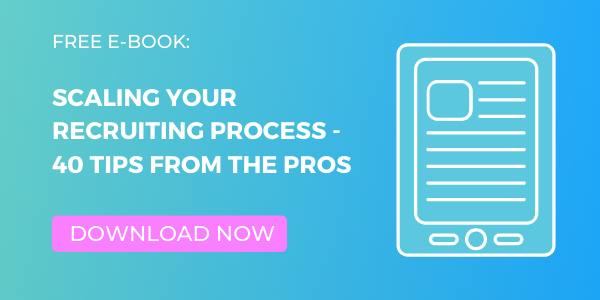Interviews are a challenge for even the most seasoned recruiter. Each candidate, hiring manager, role and situation is different, making it difficult to prepare and execute interviews consistently and effectively.
For starters, you need to understand the different types of interviews your team can conduct. You also need to prepare ahead of time for the interview. In this article, we'll cover all of this plus a few interview techniques that will surely make for a smoother, more efficient process.
Download this remote onboarding toolkit to access actionable resources you can implement and see the impact of immediately.
Table of Contents
- Breakdown: 6 Different Types of Interviews
- How to Prepare for an Interview as an Employer
- 10 Highly Effective Interview Techniques
Breakdown: 6 Different Types of Interviews

There are a number of interview types an employer can conduct when searching for the right candidate, each suited for specific stages of the recruitment process and types of candidates. Depending on the needs of the employer and applicant, some interviews can help make your recruitment process more efficient. To help you determine which interview style is best for your specific situation, we’ve broken down the differences and benefits of several types of interviews.
Phone Interview
There are a number of situations that are optimal for phone interviews. One of the most common uses for phone interviews is to narrow down a group of candidates early in the recruitment process. After reviewing a stack of applications, many companies will ask top applicants for an initial phone interview with a recruiter or hiring manager. Phone interviews can save time and resources by reducing the number of candidates you actually bring into the office.
Another reason companies may opt for a phone interview is if they are looking at candidates from out of town. Before you decide to pay for a candidate's travel expenses, conduct an initial phone interview to determine whether or not you are serious about hiring them. This is also a great option if you haven’t invested in video interview technology.
Additionally, phone interviews are a great way to reduce unconscious biases that may arise when conducting a video or in-person interview. You are unable to see what the individual is wearing, what they look like or any awkward or nervous quirks they may present during an interview. Don’t worry, we’ll get more into tips on reducing unconscious bias later in this article.
Video Interview
There are two types of video interviews you can conduct with candidates — one-way or two-way interviews. One-way interviews, or on-demand interviews, are where you provide candidates with questions and they answer them in video form on their own time. Two-way interviews are where you interview candidates live over a video stream. There are benefits to both video interview styles.
One-way video interviews can be great because they provide more consistency as well as flexibility for both the interviewer and interviewee. Job candidates are able to prepare and answer the questions on their own time, and your team can review video applications and rewatch them on your own schedule. Additionally, by asking every candidate the exact same questions without variations you will eliminate inconsistencies and question bias among different candidates.
Two-way video interviews require a bit more coordination among the interviewer and interviewee. They can be highly beneficial to see how candidates respond to questions in real time and get a better sense of their personality. These interviews also allow for a bit more variation, which if conducted thoughtfully, can provide a much more insightful and personalized interview experience.

In-Person Interview
In-person or on-site interviews are typically the most beneficial for both the employer and the candidate. In-person interviews allow for everyone to become acquainted on a more personal level and conversations are more organic than other interview styles.
These are typically saved for candidates an employer is really serious about. They require a bit more time and resources because you need to coordinate a time that works for the candidate as well as each of your interviewers. You’ll also need to schedule a place to hold the interview, and if there are multiple interviewers, it’s important to brief each of them on the candidate and establish a standard for interviewing so you can compare candidates equally. In-person interviews are a bit more on the fly than phone or video interviews because you’re having conversations in real life.
Group Interview
If you have a number of great candidates or a tight hiring timeline, group interviews are a great way to get to know several candidates in a short time period. Since you’re interviewing several people at the same time, this process can help you distinguish top candidates. They are also helpful to see how candidates work together in a team setting and compete against one another for the spotlight.

Panel Interview
The opposite of a group interview, panel interviews are where several people at your company interview an individual candidate. These are typically done as in-person interviews, but could also work as video interviews if necessary.
Panel interviews can save time by allowing all interviewers to ask questions and hear the candidate’s responses directly. However, they are more complicated because you have several people wanting to ask different questions and guide the interview in their own way. For that reason, it’s important to prepare questions ahead of time and make sure all of your interviewers are on the same page with a clear goal in mind.
Internal Promotion
Before you start the process of recruiting external candidates, you should first start by looking at your current employees to see if anyone is suitable to be promoted from within your company. Promoting people laterally or within their projected career path rewards current employees for their hard work and loyalty to your company.
Interviewing internal candidates is a bit different than interviewing external job seekers. In a lot of ways, it’s a lot easier because you already know their strengths and potential, and employees are already integrated into your company.
On the other hand, it’s a bit more difficult to turn down an internal employee, so it’s important to be up front about exactly what you need for someone to be successful in the role. Make it clear that you are also interviewing external candidates and tailor your interview questions to best suit someone who is familiar with your company and culture.

How to Prepare for an Interview as an Employer

Above all else, you need to provide job seekers with an exceptional and memorable candidate experience. To ensure your interview team is set up for success, we’ve narrowed down the essential steps to prepare for your next interview as a recruiter, hiring manager, interviewer or stakeholder.
Step 1: Know Your Ideal Candidate Persona
Before you start recruiting for an open role, create a candidate persona. Not only will personas help you create a clear and tailored job description and recruitment marketing materials, it will also help you narrow down your top applicants.
When you determine who your interviewers will be, thoroughly review your candidate persona with them. This provides them the opportunity to ask clarifying questions about the ideal candidate so they know which questions to ask and characteristics to look for.
Step 2: Understand What Your Ideal Candidate Wants
In a candidate-driven job market, it’s important to consider what your candidate persona is looking for in their ideal job. Nowadays, companies are struggling to attract, hire and retain top candidates, making it more important than ever to provide an opportunity they can’t decline. Do your research to identify what perks and benefits your candidate is looking for so your team is ready to either adapt your offer to better fit their needs or is prepared to negotiate when the time comes.
If you’re hiring for highly competitive roles, like sales candidates, software engineers, data candidates and product managers, check out our guides for what each of these types of candidates looks for in their next job.
Keep in mind that candidates aren’t solely interested in more money and better benefits. In fact, two out of three candidates seek companies that value diversity and inclusion when considering job offers. In addition to compensation, prioritize diversifying your candidate pool and create an inclusive interview process.

Step 3: Establish an Employee Value Proposition
An employee value proposition (EVP) ties the two previous points together. An EVP is a combination of the values the candidate and the employer offers the other.
Knowing what you need from an employee to succeed in the role as well as what you have to offer job seekers will greatly help you during your negotiations as well as when attracting candidates.
As part of the EVP, you should be able to clearly describe your company culture to help candidates understand what it’s like to work among their future peers. Defining your company core values will help job seekers assess if their values line up with those of your company. And all of this will help you tailor your employer branding materials to attract the highest quality candidates for your specific role and company.
Employee Value Proposition
- The value (skills, experience, personality etc.) a candidate has to offer an employer.
- The value (growth opportunities, company culture, benefits, etc.) an employer has to offer candidates.
Step 4: Review Your Job Description
Before you go into an interview, review all the materials you’ve provided the interviewee, especially the job description. The job description should outline all of the requirements and responsibilities you’re looking for based on the specific candidate persona for the role.
Create at least a few questions that revolve around the candidate’s skills and experience to get a better idea of their qualifications for the role. Candidates may come into the interview with questions about the role’s requirements, so be prepared to answer them.

Step 5: Create Structured Interview Questions
Create a structured set of interview questions, and ask each candidate the same questions. Why? Because interviews are often breeding grounds for unconscious biases. By creating structured interview questions, your team will be better able to compare responses and treat candidates equally.
Now, that’s not to say you need to ask the questions verbatim or you can’t ask candidates more specific questions about their background. It is, however, important to be cognizant of how and why your interviews differ between candidates.
Structured interview questions are also helpful for interviewers who are less experienced or might be nervous during the interview to ensure they have something to reference if they’re lost for words.
Step 6: Set an Interview Timeline
Interview timelines are important for both your team and candidates. Establishing an interview timeline will help your team better predict time-to-fill and make adjustments if they start to fall behind schedule. It’s also helpful to make sure everyone involved knows when they need to complete tasks, like booking an interview room, preparing food or drinks and scheduling a time between interviewer and interviewee.
For candidates who are likely applying to multiple roles, an interview timeline helps them determine whether they should accept another job offer or if they can wait until they interview with your team. It also helps ease their nerves by knowing when they can expect to hear back or how to prepare for the next stage. You can share this information with candidates during the application process, initial interview or even on your career page under a Frequently Asked Questions section.

Step 7: Utilize Recruitment and Interview Software
If you have the funds and resources, it's hugely beneficial to invest in recruitment tools to streamline your interview process. There are a number of tools available for pre-screening candidates, assessing soft and hard skills as well as video interviewing. For highly technical roles like software engineers and data scientists, utilizing a skills assessment tool can help your team find candidates right for your roles without requiring a technical recruiter.
Step 8: Prepare for Salary Negotiation
Negotiating salaries and compensation packages can be difficult for even the most experienced recruiters and hiring managers. Rather than go in blindly, do your research to understand exactly what candidates with your skill requirements expect in your industry, region and job market.
There are a number of factors that affect a person’s salary, so it’s important to know the candidate's worth as well as the value of the opportunity you're offering. For many candidates, salary isn’t the top priority, so take into account everything you have to offer from perks and benefits to company culture and growth opportunities.
10 Highly Effective Interview techniques

Interviews are tricky, there’s no doubt about that. While there are plenty of articles out there helping candidates prepare for their next job interview, there are far fewer resources for employers. With time, you’ll gain the skills to determine which techniques are best for different roles, hiring needs and individual candidates. Improve the range of techniques in your arsenal and make your interview process unique by incorporating these 10 skills.
Assess Soft Skills
In an era where tech skills are in high demand, 93% of employers report that it’s either “essential” or “very important” for job seekers to exemplify soft skills during their interview process. Unlike technical skills, which can be taught, it’s much more difficult to teach employees soft skills, like creativity, persuasion, collaboration, adaptability and time management — the most sought after soft skills in 2019.
You should start by identifying which soft skills your team is excelling at and which ones it’s lacking to see how new employees can fill the gaps and diversify your team. Then, you can look into different ways to assess soft skills based on types of interview questions and through in-person job shadowing.
Test Technical Skills
If you’re hiring for a technical role, it’s imperative to test for technical skills. If your team has the time and resources, create a challenge that allows candidates to show off the skills documented on their application.
Creating these tests, however, can be timely and challenging to do well, which is why it’s often worth it to invest in assessment tools. While these tools may be pricey, they’re certainly worth the investment when you’re hiring a role worth $100k+ because there’s nothing worse than hiring someone you think is a stellar candidate, only to find out their resume doesn’t reflect their skill set in reality.

Ask Behavioral or Situational Questions
During the interview, ask a variety of questions and pose different scenarios to gain a better understanding of how candidates will engage with your team and react to certain situations. These questions can test for both soft and hard skills and determine their potential for the specific role and team.
Some companies evaluate candidates by incorporating questions with real life behavioral scenarios. This can be in the form of a virtual assessment or even a brief job shadow, where a candidate actually spends time working with your team to solve a problem. Real life experiences are often better indicators of a candidate’s potential than credentials on a resume.
Conduct Job Auditions or Simulations
Similar to behavioral or situational interviews, some companies are adopting Virtual Reality (VR) and Augmented Reality (AR) technology for their interviews. These types of interviews allow candidates to simulate a job before accepting an offer, and they also help recruiters determine a candidate’s potential for the role.
These simulations are great if you’re hiring remote employees or job seekers interested in relocation because employers don’t have to front the cost of paying for travel until it’s absolutely necessary. They’re also beneficial for jobs that have an off-site location where the employee will be working, so they can get a sense of their work environment during the interview process.
Offer a Trial Period
Rather than offering the full time job out right, you can offer a candidate a trial period, whereby they test out the job for a few weeks or months. This allows both your team and the candidate to more accurately assess whether the person and role are a good match.

Organize Hackathons
Hackathons are becoming more popular as a way for community members to get together to solve problems and for companies to scout top performers for their open roles. These are particularly popular among companies hiring software developers because they are such high demand roles with a significant talent shortage.
Reduce Unconscious Bias
No matter how aware your team members are of the unconscious biases they may have, there’s always something new to learn and be aware of when building an inclusive team of diverse individuals. While your entire company should have continuing education around unconscious biases, it’s especially important for your recruiters and hiring managers to have specific training for reducing biases when reviewing applications and interviewing candidates.
This is also not exclusive to hiring external employees. It’s also important to be aware of unconscious biases when interviewing and promoting internal employees. Doing so will help mitigate the barriers certain demographics face when seeking upper-level workforce opportunities, such as the glass ceiling.
Create a Casual Interview Environment
Not all interviews require formal attire, a leather resume folder and the nervous sweats. Instead, keep it casual and ask candidates to grab a meal or coffee instead of meeting in a stuffy conference room in your office.
Consider inviting a candidate to your next team outing to create a more casual interview environment. If you’ve read over their application and resume, you probably don’t need to go over it line by line. Instead, having a casual conversation in a comfortable environment will allow candidates to relax and get to know your team on a more personal, authentic level.

Connect at Recruitment Events
Recruitment events are popular ways for companies to get to know a wide variety of candidates in the same setting. Because you have the opportunity to meet with candidates in-person, often before they’ve even submitted an application, recruitment events can also act as initial interviews. Start to ask top candidates more specific questions about their skills and experiences and encourage them to apply for your open roles.
Nowadays recruitment events aren’t limited to those standard job fairs we all know and dread. Instead, there are a bunch of new recruitment event ideas being implemented by companies eager to stand out from their competition.
Companies are now hosting recruiting events at popular local restaurants or by offering an open office event, where candidates can come and meet their prospective new team in the space they work.
Sell Your Job and Company
When top candidates are only on the job market for 10 days or less, it’s imperative that your team is simultaneously selling your open role to the candidate while also assessing their fit for the job.
There are a number of factors to consider, like your company culture and if a candidate will be a nice add to your team. You can also talk with candidates about different aspects of your culture, like team outings, employee clubs and common interests to help them see where they will fit in if they join.
Employer branding materials should also play a major role in selling your job and company to job seekers early in the recruitment process. Additionally, your employee value proposition will be greatly helpful in identifying the value candidates have to offer as well as what you can sell employees about your career opportunity.
Needless to say, there’s a lot to consider when preparing for and interviewing prospective job candidates. This guide should help you better understand how and why you need to thoroughly prepare for an interview as an employer. For more support in your recruiting and hiring efforts, check out more of our tech recruiter resources and get the right talent in the door sooner.
Use our template to seamlessly calculate your own employee retention rate.




